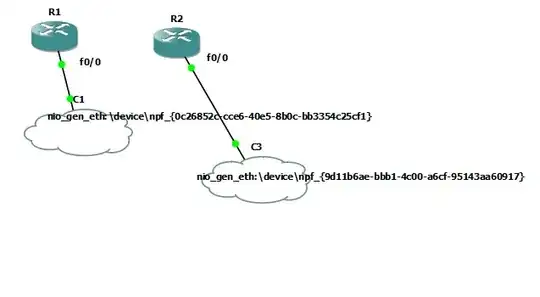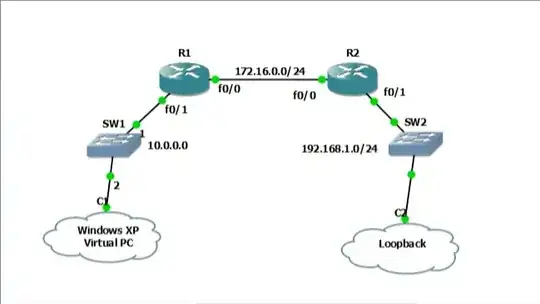I am building a lab environment for CCNA training, using GNS3. The GNS3 network is connected to a real network, let's call it LAN 1.
LAN 1 is not connected to the internet and is completely wired Ethernet. A single instance of GNS3 runs on a Windows 7 Enterprise host. The same host also runs a VMWare Ubuntu 10.0.04 guest. R1 is connected to the Microsoft Loopback adapter (C1), and R2 is connected to the normal Ethernet adapter (C3) as shown in the topology below. ipconfig shows that the Windows 7 host (running GNS3) has IP 10.10.10.167. An nmap scan from this same host, with target set to its default gateway of 10.10.10.252 says that we have a Cisco router (but I don't have physical access to know what model it is).

ipconfig output.
Ethernet adapter MS-loopback-adapter:
Connection-specific DNS Suffix . :
Link-local IPv6 Address . . . . . : fe80::78cf:e504:8742:e683%19
Autoconfiguration IPv4 Address. . : 169.254.230.131
Subnet Mask . . . . . . . . . . . : 255.255.0.0
Default Gateway . . . . . . . . . :
Ethernet adapter Local Area Connection:
Connection-specific DNS Suffix . :
Link-local IPv6 Address . . . . . : fe80::f0b4:a6be:31b:924%12
IPv4 Address. . . . . . . . . . . : 10.10.10.167
Subnet Mask . . . . . . . . . . . : 255.255.255.0
Default Gateway . . . . . . . . . : 10.10.10.252
Ethernet adapter VMware Network Adapter VMnet1:
Connection-specific DNS Suffix . :
Link-local IPv6 Address . . . . . : fe80::2997:a8ce:7df5:b968%16
IPv4 Address. . . . . . . . . . . : 192.168.129.1
Subnet Mask . . . . . . . . . . . : 255.255.255.0
Default Gateway . . . . . . . . . :
Ethernet adapter VMware Network Adapter VMnet8:
Connection-specific DNS Suffix . :
Link-local IPv6 Address . . . . . : fe80::68ea:2034:c05f:b3f2%17
IPv4 Address. . . . . . . . . . . : 192.168.14.1
Subnet Mask . . . . . . . . . . . : 255.255.255.0
Default Gateway . . . . . . . . . :
!
ip forward-protocol nd
!
!
no ip http server
no ip http secure-server
!
R1.cfg
!
interface FastEthernet0/0
ip address 10.10.10.170 255.255.255.0
speed 100
full-duplex
!
R2.cfg
!
interface FastEthernet0/0
ip address 10.10.10.160 255.255.255.0
speed 100
full-duplex
!
The problem is that neither R1 nor R2 can ping the Windows 7 host (running GNS3) 10.10.10.167 as shown for R2 below (the console of R1 and R2 are basically the same).
R2(config)#ip address 10.10.10.160 255.255.255.0
R2(config)#no shutdown
R2(config)#ip route 0.0.0.0 0.0.0.0 10.10.10.252
R2#show ip route
Gateway of last resort is 10.10.10.252 to network 0.0.0.0
10.0.0.0/24 is subnetted, 1 subnets
C 10.10.10.0 is directly connected, FastEthernet0/0
S* 0.0.0.0/0 [1/0] via 10.10.10.252
R2#ping 169.254.230.131
Type escape sequence to abort.
Sending 5, 100-byte ICMP Echos to 169.254.230.131, timeout is 2 seconds:
.....
Success rate is 0 percent (0/5)
R2#ping 10.10.10.167
Type escape sequence to abort.
Sending 5, 100-byte ICMP Echos to 10.10.10.167, timeout is 2 seconds:
.....
Success rate is 0 percent (0/5)
I've set the Gateway of last resort to 10.10.10.252 which is the actual default gateway for the real LAN which my GNS3 host is on. Still for both R1 and R2, the ping on 10.10.10.167 (the regular ethernet adapter of the GNS3 host) and the loopback adapter 169.254.230.131 has no success. Why can't R1 and R2 see my real LAN? What am I missing here?
I actually have run into lots questions so far and (assuming this is not off-topic) plan to create a series of posts after this.
